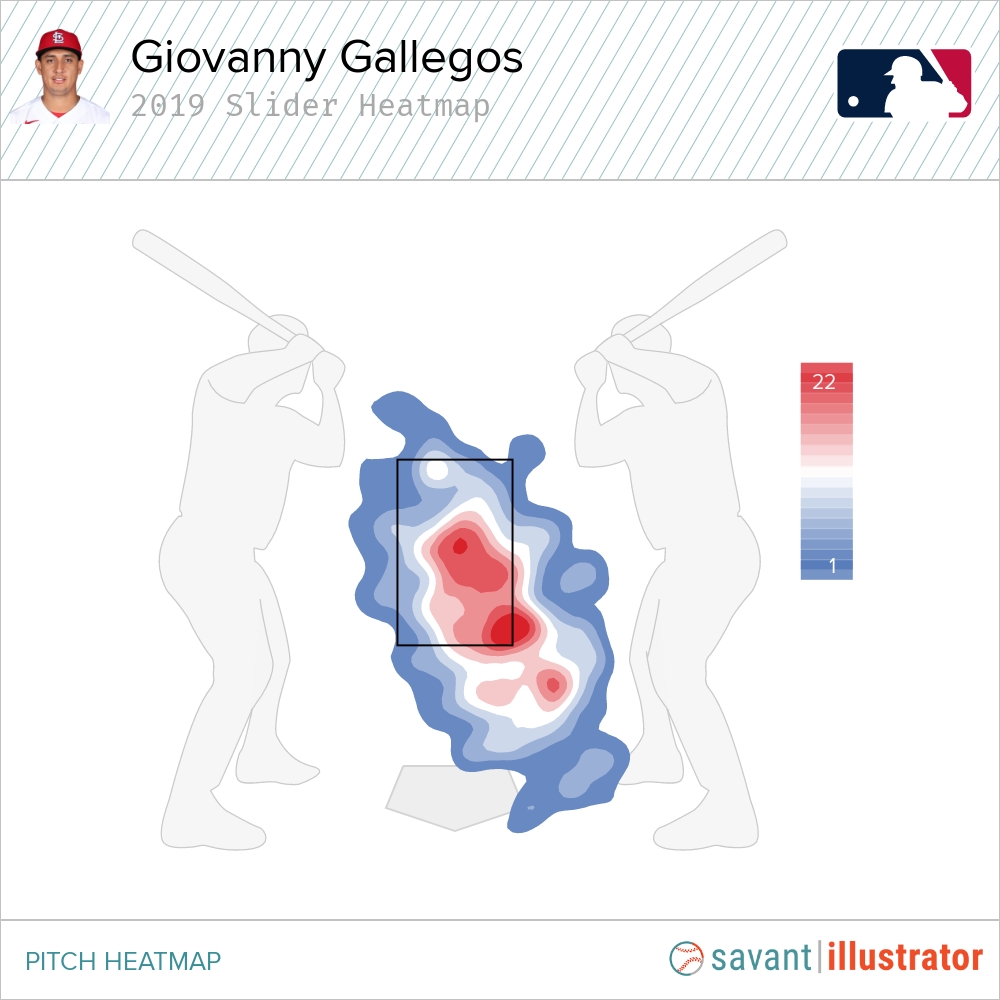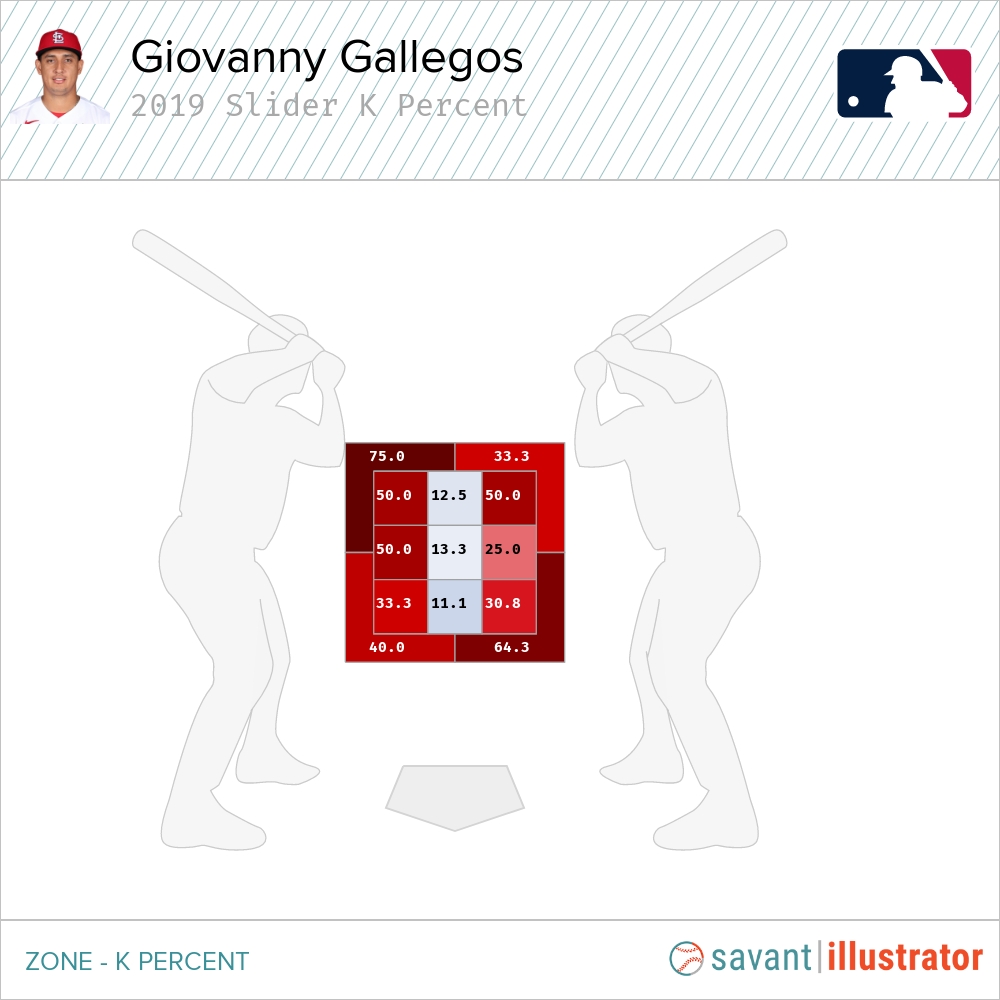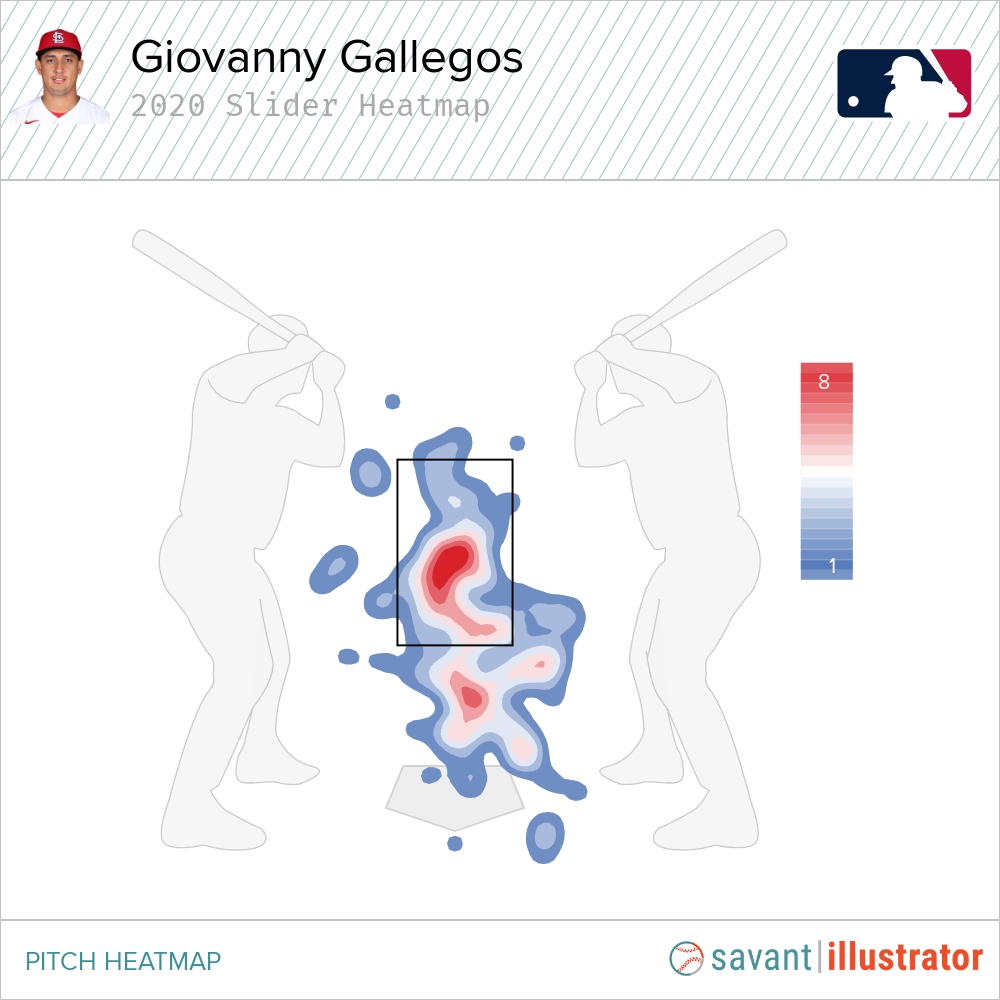If one looks at Roster Resource’s Cardinals Depth Chart projection for 2021, the St. Louis closer situation appears hazy. Roster Resource lists four closer options, and it’s reasonable to think that all of them could be thrust into the role in some way, shape, or form in 2021.
Alex Reyes and Jordan Hicks both offer live fastballs as possible closer options. Reyes averaged 97.6 MPH on his fastball last season, and Hicks, who opted out in 2020 due to COVID, sported one of the fastest heaters in baseball in 2019, as he averaged 101.2 MPH on a pitch he threw 61 percent of the time.
The Cardinals could also go with Andrew Miller in a platoon role, and while his Cardinals tenure has been a mixed bag, (he posted a 4.23 xERA in 2109), he is coming off a nice bounce-back campaign in 2020 (2.77 ERA; 2.13 xERA in 16 appearances and 13 innings). Furthermore, he is a big name who has played on competitive teams in Boston, Baltimore, New York, and Cleveland, which may be needed for a club that could be the favorites in a weakened NL Central in 2021.
However, the best option for the Cardinals in the ninth inning in 2021 may be the least heralded of the four: 29-year-old Giovanny Gallegos.
Let’s take a look at Gallegos’ profile, what he could offer the Cardinals in 2021, and if he indeed could be the Cardinals’ main option in the ninth-inning next year and perhaps even beyond.
Finding Success in the “Show Me” State
Gallegos was originally signed by the New York Yankees in 2011 out of the Mexican League, but he failed to gain much attention in the Yankees system. He did not debut in the Majors until 2017, as he made 16 appearances and pitched 20.1 innings with the Yankees that season. Though his ERA numbers were a bit suspect (4.87 ERA, 4.99 xERA) in his MLB debut, he did showcase solid control metrics, as he posted a 4.40 K/BB ratio, which was further highlighted by a 25 percent K rate.
However, hitters barreled him quite a bit, as evidenced by hitters’ 10 percent barrel rate against him in 2017. This barrel rate, combined with a high amount of fly balls (0.84 GB/FB ratio), and a ballpark that tends to punish flyball pitchers, had a big impact on his surface-level numbers, and it is not a surprise that Gallegos became expendable to the club after 2017.
In 2018, the Mexican-born reliever pitched most of the year in Triple-A, as he made 17 appearances in Scranton/Wilkes-Barre and only four appearances with the Yankees before being traded near the trade deadline in a deal to St. Louis that brought Luke Voit to the Bronx.
At first, the move appeared to be a knife to the gut for Cardinals fans. Not only did they trade a hometown guy in Voit, who ended up breaking out with the Yanks, but they also seemed to acquire a pair of relievers in Gallegos and Chasen Shreve who didn’t seem like they would move the needle much in the Cardinals’ pen. Gallegos spent most of his time in 2018 in Memphis, the Cardinals Triple-A organization, as he made 13 appearances with the Redbirds (and only two appearances with the Cardinals).
Despite starting the 2019 campaign in Memphis, the Cardinals called up Gallegos in early April of 2019 and the former Yankee farmhand didn’t look back. Gallegos made 66 appearances and pitched 74 innings in his first full season in the Majors, and not only posted a 2.31 ERA and 2.68 xERA but also accumulated an fWAR of 1.6, according to Fangraphs. Granted, the Cardinals primarily went with Carlos Martinez and Hicks in the ninth, as they saved 24 and 14 games, respectively in 2019 (Gallegos only saved one game). However, Gallegos finished second in holds with 19 (behind only Miller), and he also led Cardinals relievers with 20 or more innings in context-neutral wins (WPA/LI) with 2.31, according to Fangraphs.
So how did Gallegos find such late-blooming success on the eastern side of the “Show Me State”?
Well, he primarily succeeded with a four-seam fastball and slider pitch arsenal that limited walks (5.7 percent walk rate in 2019) and maximized whiffs (34.6 percent whiff rate overall in 2019). Here’s how each of his pitches fared in 2019, according to Baseball Savant data.
| Year | Pitch | RV/100 | Run Value | Pitches | Pitch % | wOBA | Whiff % | K % | Put Away % |
|---|---|---|---|---|---|---|---|---|---|
| 2019 | 4-Seamer | -2 | -13 | 626 | 54.9 | 0.265 | 22.9 | 28.5 | 18.8 |
| 2019 | Slider | -2.9 | -15 | 501 | 43.9 | 0.201 | 49.6 | 40.2 | 27.8 |
On a run value basis, Gallegos generated two of the best five pitches thrown by Cardinals pitchers in 2019, according to Savant. Gallegos’ fastball ranked fourth, and his slider ranked second in run value of Cardinals pitches thrown in 2019. Furthermore, his slider was only six runs worse than Jack Flaherty’s fastball, even though Gallegos threw nearly his slider nearly a thousand fewer times than Flaherty’s best pitch.
While run value definitely showcases how effective Gallegos’ slider was in 2019, it’s even more interesting when one ganders at the pitch’s heatmap from 2019.

As one can see from the heatmap above, he was able to hit that glove side of the zone with regularity, which led to incredible success with the pitch. This success was showcased by his strikeout rate on the pitch, especially in that lower right side of the plate. Let’s take a look at the K chart below:

Furthermore, let’s take a gander at how the pitch looked against an opposing batter in 2019. In the GIF below, Gallegos not only strikes A’s slugger Khris Davis on the low and away slider but does so on a 3-2 count, which displays the massive confidence he had in the pitch nearly two seasons ago.
Based on the metrics and results from 2019, it is hard to argue that any other Cardinals reliever had a more effective pitch than Gallegos and his slider.
Taking a Step Back in 2020
With Hicks sitting out in 2020 due to COVID concerns, the Cardinals closer position seemed open for the taking for Gallegos. However, Gallegos dealt with a variety of ailments in 2020 that prevented him from being the Cardinals’ lone option in the ninth.
He first caught COVID in July, which put him behind in Summer Camp, and then he also struggled through a groin injury which put him on the IL in September. All these different issues limited him to not only 16 appearances and 15 innings pitched but also affected his overall effectiveness on the mound, as his ERA rose to 3.60 and his strand rate dropped dramatically from 87.3 percent in 2019 to 60.3 percent in 2020.
The biggest decline though for Gallegos came in the effectiveness of his four-seam fastball. After a -13 run value on the pitch in 2019, the pitch had a +1 run value last year, nearly a 14 run difference. The pitch also saw a decline in K rate (from 28.5 percent in 2019 to 22.2 percent in 2020) as well as a dramatic rise in hard-hit rate (from 41.8 percent in 2019 to 52.6 percent in 2020). Thus, it is not surprising that Gallegos threw the four-seam fastball dramatically less in 2020, throwing it just 48.5 percent of the time (he threw it 54.9 percent of the time in 2019).
In addition, let’s take a look at his fastball-slider combo in 2020, according to Savant data:
| Year | Pitch | RV/100 | Run Value | Pitches | Pitch % | wOBA | Whiff % | K % | Put Away % |
|---|---|---|---|---|---|---|---|---|---|
| 2020 | 4-Seamer | 1 | 1 | 111 | 48.5 | 0.339 | 21.8 | 22.2 | 20.7 |
| 2020 | Slider | -2.1 | -2 | 116 | 50.7 | 0.141 | 49.4 | 50 | 27.3 |
As evidenced from the table above, Gallegos’ fastball did see some regression from 2019 to 2020. However, his slider remained as effective as ever. While his total run value was far less than 2019, his RV/100 (run value per 100 pitches) on the slider only had a 0.8 difference from 2019. Furthermore, he generated a 50 percent K rate and a near 50 percent whiff rate with his slider, which was pretty similar to 2019 (49.6 percent whiff rate; 40 percent K rate).
What is interesting though about his slider in 2020 is that he didn’t really hit that same part of the plate as regularly as in 2019. The heatmap on his slider from 2020 shows that the slider hovered a little more in the center-middle and lower-middle of the zone, just outside of the strike zone, in comparison to the previous season:

The difference in the heatmap will be interesting to pay attention to in 2021, as it will be interesting to see whether his 2021 one will be closer to 2019 or 2020. Of course, 2020 is a pretty small sample, as he only threw his slider 116 times. This is a minute number in comparison to 2019, where he threw the pitch 501 times.
Nonetheless, Cardinals fans have to be encouraged by this data and the continued effectiveness of his slider in 2020. Furthermore, Gallegos also was better at generating groundballs in 2020, as he increased his groundball rate from 33.5 percent to 41.9 percent. That could be an important development, especially if his fastball doesn’t match those 2019 run values again in 2021. If Gallegos can generate more batted balls on the ground next year, that could be a tool to help Gallegos get extra outs in crucial spots, especially if he’s not generating strikeouts or whiffs with the slider.
Gallegos and CSW
Some people on the Pitcher List Discord were talking about Gallegos’ CSW rate, so I decided to do some research on my own on Savant concerning Gallegos’ CSW and how he compared to other key Cardinals relievers from the past two years (i.e. Miller, Reyes, Hicks, and John Gant).
Let’s take a look at how Cardinals relievers, who may be in the hunt for the closer’s role in 2021, fared regarding CSW last year:
| StL Pitcher | CSW pitches | CSW % |
|---|---|---|
| John Gant | 87 | 36.3 |
| Giovanny Gallegos | 83 | 36.2 |
| Andrew Miller | 68 | 33.2 |
| Alex Reyes | 103 | 29.9 |
Gant tops the list, but just barely over Gallegos. Of the group, Reyes fares the worst, which is a bit disappointing considering his prospect pedigree. Now, let’s take a look at the 2-strike CSW percentage from the same group of pitchers in 2020.
| StL Pitcher | CSW pitches | CSW % |
|---|---|---|
| Giovanny Gallegos | 21 | 9.2 |
| Andrew Miller | 16 | 7.8 |
| John Gant | 18 | 7.5 |
| Alex Reyes | 25 | 7.2 |
When it comes to generating called strikes and whiffs with two strikes, Gallegos was the best of the Cardinals bunch a year ago. His CSW percentage with two strikes was 1.4 percent higher than Miller and 1.7 percent higher than Gant, who actually led Gallegos by 0.1 in general CSW. Hence, when Gallegos got two strikes on a hitter, he tended to be the most effective of the bunch.
Now it is important to include Hicks in this data, so I decided to take a look at a two-year sample of CSW that also included 2019-2020 data. Here is what I found about that two-year CSW data:
| StL Pitcher | CSW pitches | CSW % |
|---|---|---|
| Giovanny Gallegos | 488 | 35.6 |
| Andrew Miller | 384 | 32.6 |
| Jordan Hicks | 140 | 30.8 |
| John Gant | 408 | 30.3 |
| Alex Reyes | 117 | 28.1 |
Over the past two seasons, Gallegos has been the superior reliever of the five listed when it comes to CSW. Even with Hicks in the equation, he still is 4.8 percent behind Gallegos in terms of CSW. Furthermore, Reyes CSW continues to look worse over a two-year sample, as his CSW is 7.5 percent lower than Gallegos.
Lastly, let’s take a look at the CSW % with two strikes from the 2019-2020 sample.
| StL Pitcher | CSW pitches | CSW % |
|---|---|---|
| Giovanny Gallegos | 114 | 8.3 |
| Andrew Miller | 86 | 7.3 |
| Jordan Hicks | 31 | 6.8 |
| Alex Reyes | 26 | 6.3 |
| John Gant | 78 | 5.8 |
Once again, Gallegos remains at the top, and surprisingly, Gant has been the worst over the past two years in two-strike CSW, a surprise considering Gant was the best pitcher of the sample in general CSW in 2020.
However, while Gant held the slight lead over Gallegos in that one category, Gallegos led considerably in the other three tables shared. Thus, despite his struggles in 2020, Gallegos has proved over the past two years that he is one of the best pitchers in the Cardinals bullpen when it comes to generating strikes.
What Could Hold Gallegos Back in 2021?
As of now, a lot of advanced metrics point to a Gallegos bounce back in 2021. Furthermore, considering his ability to generate whiffs and K’s and limit walks, it seems like a no-brainer that Cardinals manager Mike Shildt should at least explore Gallegos in the closer’s role in some fashion in 2021. That being said, what could prevent Gallegos from being a breakout closer for St. Louis next season?
Health will be the biggest issue that could impede Gallegos. His groin injury certainly had an effect, and it sidelined him for considerable stretches of time. It will be interesting to see if Gallegos will be fully recovered this Spring, or if this injury will flare up again next year. Groin injuries can tend to linger, and his health in this area will be worth paying attention to for Cardinals fans.
Lastly, his fastball will be key to watch. His slider seems to be elite, as he has generated near 50 percent whiff rates with the pitch the past two years. That being said, his fastball went from pretty good in 2019 to pretty mediocre in 2020, and that had a dramatic effect on his ERA and other metrics. It is difficult to think that his fastball will be a -13 run value pitch again in 2021 or beyond. However, if he can get any negative value on that pitch, that could be a good sign that Gallegos is starting to revert to his pretty “elite” self from 2019.
Gallegos doesn’t have the flashy stuff or prospect pedigree as some of the other options that Shildt may have at his disposal in the ninth inning. However, for the past two seasons, Gallegos has become one of the more underrated relievers in the National League, maybe in all of baseball, mostly thanks to his terrific slider.
That being said, if he has another solid season in 2021 with the Cardinals, it may be time to take notice and stop calling him “underrated”.

